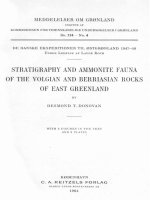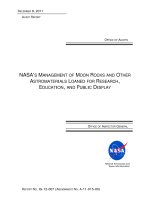Sedimentary rocks
Bạn đang xem bản rút gọn của tài liệu. Xem và tải ngay bản đầy đủ của tài liệu tại đây (6.69 MB, 46 trang )
Important Announcements
Midterm Update:
Test Rescheduled!
NEW DATE: March 5,
(Wednesday, next week).
• Midterm will cover:
Prelude, Chapters 1-7 &
Interludes A & B
• To help you prepare,
There will be another
10 pt/15 question quiz
this Friday (Feb. 28)
Covering Chapters 5-7,
& Interludes A & B.
•Test questions for
Chapter 7 (Metamorphic
rocks will be based on
lecture.)
Today’s Lecture:
Chapter 7: Sedimentary Rocks
Origin and nature of
sedimentary rocks:
• Sedimentary
environments
• Place in rock cycle
• Basic weathering
processes
• Basic erosion
(transport) processes
• Soils
•Types of sedimentary
rocks: Chemical
Origin of
Sedimentary
Rocks
- Derived through the weathering and erosion of pre-existing rocks.
- Form by the transport and accumulation of fragmental materials
(sediments) or dissolved products, from a source region to a site of
deposition.
- Sediments are constantly being produced at the Earth’s surface
and sedimentary deposits are widespread.
- 75% of all rock outcrops on continents are sedimentary.
- Provide a record of past events and environments.
- Very important economically!
Sedimentary Processes
Two basic environments:
◆ On-land (continental)
◆ In the ocean (marine)
Shorelines = “transitional” environments.
Physical &
chemical weathering
at source.
Erosion (transport)
& local deposition.
Sedimentary
environments &
processes.
Deposition,
burial,
lithification.
Sedimentary Rocks and the Rock Cycle
Older sedimentary rocks
(conglomerate)
being recycled into
new sediments
Clasts of many different types
of older rocks in a conglomerate.
Sedimentary Rocks and the Rock Cycle
Volcanic rocks
(basalt flows on Hawaii)
being turned
into sediments.
Basalt flows
Basalt gravels
Older sedimentary rocks
Younger dune
sands
Dune sands derived
from nearby outcrops
of older sedimentary rocks.
Black Sand Beach, Hawaii
Basalt flows
Basalt sands
Mechanical Weathering:
Factors affecting the physical break-up of rocks
1. Frost wedging
freeze/thaw cycle (ice expands)
2. Unloading
remove overlying rock: less pressure
3. Thermal Expansion
hot/cold = expand/shrink
4. Organic Activity
plants/animals/humans
Fig. 7.05a
© Martin Miller
Sheeting and exfoliation in granite
Fig. 7.05b
Stephen Marshak
Joints (natural fractures)
Mechanical Weathering
Ways to physically
break up rocks:
Fig. 7.06a
Frost wedging.
Crystallization
of salts.
W. W. Norton
Root growth.
Thermal
expansion
Physical processes work hand in hand
with chemical to accelerate weathering.
Fig. 7.08
W. W. Norton
Thermal Expansion
Temperature
changes (day-night
cycles) produces
differential expansion
& contraction of the
minerals in a rock.
This loosens
grain boundaries,
causing a rock
to literally fall apart.
Chemical Weathering
Hydrolysis:
K-Feldspar + water
(carbonic acid)
Kaolinite clay +
ions in solution
(silica, potassium, etc.)
Oxidation:
Ferric iron + Oxygen
Hematite
(iron oxide or “rust”)
Weathered
granite
Fig. 7.03
Dissolution
Fig. 7.07a
W. W. Norton
Fig. 7.07b
W. W. Norton
Dissolution
of
limestone
Fig. 7.07c
W. W. Norton
Carbon
dioxide
dissolves
in water
to make
a weak
acid
(carbonic)
Attacks
& dissolves
rocks.
Carbonate
is especially
vulnerable.
W. W. Norton
Fig. 7.10c
Stephen Marshak
Spheroidal weathering of granite
Fate of Weathering
Products
W. W. Norton
Products of long-term weathering and erosion:
Quartz and clay









